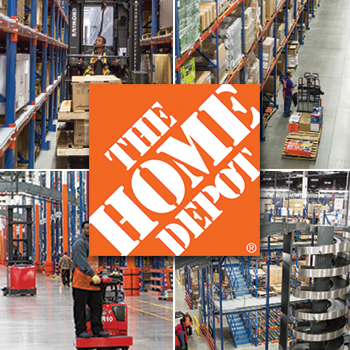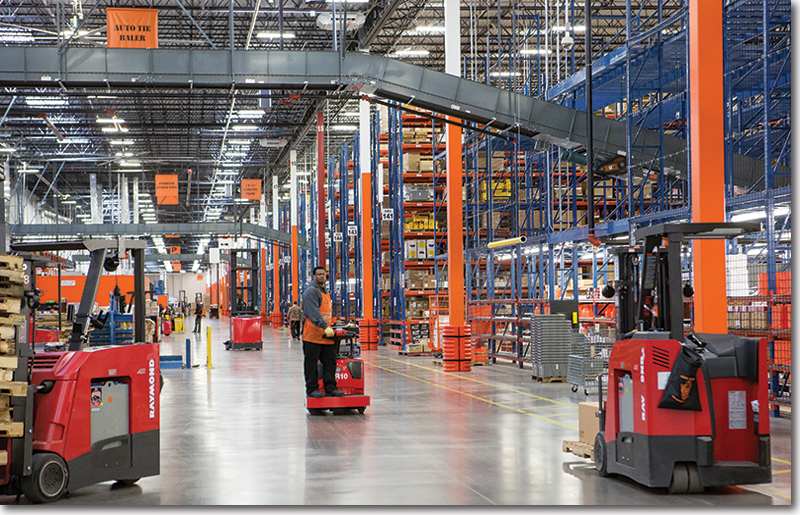Home Depot Builds an Omni-Channel Supply Chain

The Home Depot has remodeled its supply chain in recent years, building the foundation for a new type of fulfillment center intended to blend online and in-store shopping.
“Would you like to pick this up in the store or have it delivered?”
The Home Depot asks each of its online shoppers this seemingly simple question.
The process of building a distribution network to satisfy the answer has taken the better part of six years, and there is still work to be done.
The transformation is not a matter of simply accommodating growth of the e-commerce channel, which, although it’s the fastest-growing segment, still makes up only a small part of the company’s overall sales.
Instead, having recognized the customer value of online product research and inventory visibility, Home Depot has restructured its supply chain to integrate the experiences of online and in-store shopping.
That restructuring included the development and deployment of a network of distribution centers for store replenishment and, more recently, direct-to-customer fulfillment. Home Depot prefers to think of all its transaction processes as fulfillment, regardless of how it meets the customer.

“In fact, we prefer to take the ‘e’ out of e-commerce and just call it commerce,” says Scott Spata, vice president of supply chain direct fulfillment for The Home Depot. “A high number of in-store transactions start online, where we can drive customers to the store armed with all the information they could need. Alternatively, they might want to see and touch a product in a showroom before ordering a specific size or color online. However the customer wants to transact, we’ll make it happen on the back end.”
The latest addition to the company’s network is the direct fulfillment center (DFC), designed to support omni-channel capabilities like direct-to-consumer fulfillment and store pickup for online orders.
Home Depot worked with an integrator (Intelligrated) to build one DFC in California, one in Georgia, and a third due to come online next year in Ohio.
Inside the newest DFC in Locust Grove, Ga., an assortment of light automation and conventional picking processes are coordinated in real time with a goal of same-day order shipping. What truly sets the facility apart is a warehouse control system that synchronizes order fulfillment activities.
This system ensures the components for a multi-line order arrive at the right packing area in close proximity to one another and balances the workload at single-line pack stations and multi-line, light-directed put walls.
Although the DFCs are the spearhead of Home Depot’s response to the omni-channel revolution, they would not be possible without a massive remodeling of the company’s supply chain.
Supply Chain Transformation
It began in 2007, when Spata says Home Depot’s direct-to-store distribution model was very decentralized. Each store was tasked with ordering, replenishing and managing inventory, which consumed as much as 60% of store labor.
“There was so much work that took associates away from the customers,” Spata says. “We thought it would be great if we could turn all that labor into customer-facing hours.”
The supply chain team set about building a replenishment algorithm that took stock management responsibilities away from individual stores and placed them with a centralized inventory and replenishment department. The company was ultimately able to achieve 99% inventory in stock in the stores on top-selling SKUs while improving inventory turns, but not before it took a hard look at its supply chain. Replenishment turned out to be the catalyst for DC transformation.
“If you move to a just-in-time replenishment model, then you need a supply chain that can support those activities,” Spata says. “We could have gone with a traditional stocking DC, load it with safety stock, then start dropping orders and shipping out truckloads. We decided to take it one step further.”
Instead of stocking a lot of domestic product, Home Depot built a series of what it calls rapid deployment centers (RDCs). Suppliers and vendors no longer ship thousands of orders to Home Depot stores, but create 18 aggregate orders bound for 18 North American RDCs. In turn, these facilities disseminate items through the rest of the company’s network. Spata says the economies of scale have dramatically improved logistics costs both into and out of the RDCs, and suppliers are better able to manage production runs.
“Once the product enters the RDC, flow-through is processed almost entirely in the same day,” Spata says. “Instead of a less-than-truckload hub to last-mile delivery, we can do that even faster with the core network.”
Upon arrival at the RDC, product might be crossdocked and allocated to stores based on real-time demand. Spata says the speed of replenishment is greatly improved, so that even if a big customer comes into a store and buys all of a particular SKU, the total time it spends out of stock is much less than before RDCs.
The new RDCs are a valuable complement to the company’s legacy network of DCs, which often included antiquated infrastructure and materials handling equipment. Because the older DCs were not geared toward speed of processing, online orders might ship in one to three days at best. Spata began looking at solutions that could enable an entirely new facility design to achieve same-day shipping - not to be confused with same-day delivery - of orders from a Web site or in a store.
He knew such a facility would need to take on faster-moving SKUs that were going vendor-direct in addition to a longer tail of slower-moving SKUs as merchants complement in-store inventory with a more diverse range online. As Home Depot began working on this initiative, they dubbed the new facilities direct fulfillment centers, or DFCs.
While designing a new type of facility built for speed, Spata considered his existing brick-and-mortar footprint. With more than 2,000 stores in the United States, each with about 35,000 SKUs, geographically located in just about every major metropolitan area, the new DFCs could leverage store inventory with omni-channel algorithms to greatly improve speed of delivery or pickup of goods based on the customer needs in an interconnected environment.
As a result, Spata’s team chose a target service level from DFCs of no more than two-day parcel delivery to 90% of e-commerce customers in the United States. Leveraging store-stocked SKUs for same-day pickup of buy online or pick up in store capabilities, the math suggested three regional DFC locations.
Inside the Four Walls
Think of this supply chain remodeling project in three phases. Phase one involved the creation of centralized replenishment. Phase two saw the build-out of Home Depot’s RDC distribution network for store replenishment. The company’s new DFCs are the third phase, targeted squarely at meeting the e-commerce challenge. The most challenging aspect of the three new facilities was the complete uncertainty of their future activity.
“The beauty of the RDC build was that we already knew the SKUs and attributes of what people were buying in stores. We knew how to run that play,” Spata says. “For the DFCs, we had to build tremendous flexibility for what we would get, which was entirely unknown. We knew what we had for e-commerce volume at that time, but we also knew we would double, triple or quadruple that in coming years. This is not just growth, but hypergrowth.”
The uncertainty, combined with the dimensional irregularity of home improvement products, led Spata away from an investment in heavy automation. “We just don’t have enough flow of small, slow-moving products to justify shuttles or a goods-to-person solution,” he says. “At least not yet.” However, the DFC facilities are large: At 1.1 million square feet, the Locust Grove facility is not even the biggest. Inside are proven, state-of-the-art technologies including conveyor systems, voice-directed batch picking, RF scanning for picking and putaway, light-directed put walls, and about 17 different storage solutions.
“A vanity is a lot different than a drill bit, but although product is on average much bigger and bulkier than in a traditional e-commerce site, we still handle plenty of smaller items,” Spata says. “We want to be ready no matter which category grows the fastest.”
In evaluating potential workflows for the new DFCs, Spata’s team looked at a number of models. “Are we going to pick an order to a tote so it has to travel the whole building? Or, do we bring the order together at the end? There are pros and cons with both,” Spata says. “Then we had to complement conveyable orders with bulk floor space, since the non-conveyable play is just as important for us.”
The team decided on a consolidation approach where single-line and multi-line orders might be picked from pallet flow rack, pallet selective rack, piece-pick modules or bulk storage before they are conveyed to a pack station (single-line orders) or married together at put walls (multi-line orders). Multi-line orders that include both non-conveyables and conveyables are married together in the shipping area. Spata says this design leverages the vertical cube of the building while preserving the flexibility to reassign labor and react to seasonal and daily peaks.
As compared to its traditional DCs, the new facilities achieved a 50% improvement in speed of order processing. This also halved the time of standard delivery to customers, who receive parcel products in one to two days for regionally stocked SKUs instead of three to five days. At the same time, the facility’s pick, pack and ship costs are already better than expected in the short time since implementation.
Taking the ‘E’ Out of E-commerce
Spata emphasizes that Home Depot’s DFCs and e-commerce approach are not a discrete channel, but part of an interconnected retail environment. When stores, Web sites, DCs, RDCs and DFCs are unified, customers have a range of options.
A customer visiting the Web site simply to confirm an item is in stock before heading to the store can also see the product’s location in an aisle and shelf. After researching a vanity online, the customer can visit the store and ask for one to be delivered to a home or job site. Or, the customer might select a model in the store and order a different color online or through a store kiosk.
“The shopping experience often starts online, and we’re seeing that it drives footfalls in the stores,” Spata says. “But that approach also decreases the burden on floor space inside the stores. Instead of a huge assortment of appliances in the showroom, we can offer a much deeper selection online. Most importantly, the supply chain allows customers to transact how they want to.”
This includes returns and reverse logistics. Home Depot offers “buy online, pickup in store,” and “buy online, ship to store,” but Spata says the “buy online, return to store” option is consistently atop customer satisfaction data. “The idea that they can go to any store and get credit for something they bought online is the No. 1 thing they love about our customer service,” he says.
The fastest-growing segment is customers who want items delivered to them. Spata says Home Depot has always offered “deliver from store” for walk-in customers, but the company is working to build out the capability to “buy online, deliver from store.”
“Omni-channel is about starting to look at global inventory,” Spata suggests. “Using stores as fulfillment centers is an interesting idea, but at the same time fulfilling in a store is probably the highest cost model to do that. They are not designed or staffed like a DC.”
If the customer chooses free shipping because they can wait five days for the delivery, Spata says it often makes the most sense to fill the order in a DC. But if the customer says they need it in one day, it might be better to ship from the nearby store. In either case, more saving and more doing have become the power of The Home Depot.
Related: Home Depot’s Flexible Picking Processes Achieve Same-Day Order Fulfillment

Article Topics
Honeywell Intelligrated News & Resources
Southern Glazer’s Wine & Spirits: Proof positive innovation Southern Glazer’s Wine & Spirits: Proof positive innovation Time to integrate those robots Empower Your Automation Journey at ProMat 2023 Conveyors and sorters surge ahead Raise Your Operational Intelligence Report: Automation “a Matter of Survival” More Honeywell IntelligratedLatest in Warehouse|DC
Spotlight Startup: Cart.com Walmart and Swisslog Expand Partnership with New Texas Facility Taking Stock of Today’s Robotics Market and What the Future Holds U.S. Manufacturing Gains Momentum After Another Strong Month Biden Gives Samsung $6.4 Billion For Texas Semiconductor Plants Walmart Unleashes Autonomous Lift Trucks at Four High-Tech DCs Plastic Pollution is a Problem Many Companies are Still Ignoring More Warehouse|DCAbout the Author
















